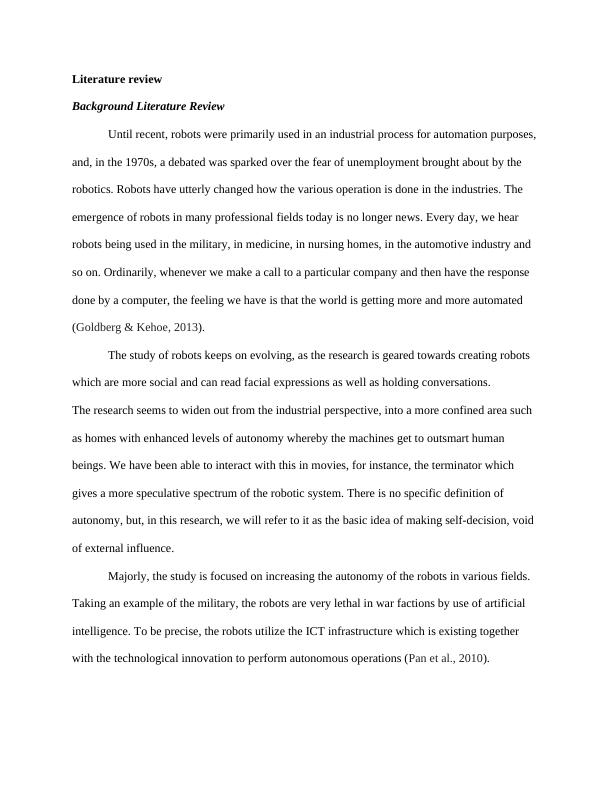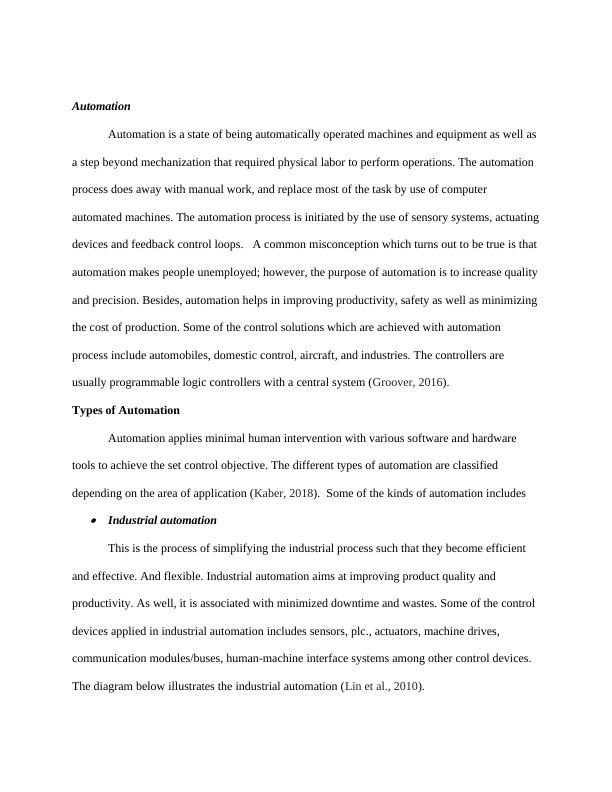Automation and Types of Automation
Added on 2023-04-23
9 Pages1627 Words488 Views
Literature review
Background Literature Review
Until recent, robots were primarily used in an industrial process for automation purposes,
and, in the 1970s, a debated was sparked over the fear of unemployment brought about by the
robotics. Robots have utterly changed how the various operation is done in the industries. The
emergence of robots in many professional fields today is no longer news. Every day, we hear
robots being used in the military, in medicine, in nursing homes, in the automotive industry and
so on. Ordinarily, whenever we make a call to a particular company and then have the response
done by a computer, the feeling we have is that the world is getting more and more automated
(Goldberg & Kehoe, 2013).
The study of robots keeps on evolving, as the research is geared towards creating robots
which are more social and can read facial expressions as well as holding conversations.
The research seems to widen out from the industrial perspective, into a more confined area such
as homes with enhanced levels of autonomy whereby the machines get to outsmart human
beings. We have been able to interact with this in movies, for instance, the terminator which
gives a more speculative spectrum of the robotic system. There is no specific definition of
autonomy, but, in this research, we will refer to it as the basic idea of making self-decision, void
of external influence.
Majorly, the study is focused on increasing the autonomy of the robots in various fields.
Taking an example of the military, the robots are very lethal in war factions by use of artificial
intelligence. To be precise, the robots utilize the ICT infrastructure which is existing together
with the technological innovation to perform autonomous operations (Pan et al., 2010).
Background Literature Review
Until recent, robots were primarily used in an industrial process for automation purposes,
and, in the 1970s, a debated was sparked over the fear of unemployment brought about by the
robotics. Robots have utterly changed how the various operation is done in the industries. The
emergence of robots in many professional fields today is no longer news. Every day, we hear
robots being used in the military, in medicine, in nursing homes, in the automotive industry and
so on. Ordinarily, whenever we make a call to a particular company and then have the response
done by a computer, the feeling we have is that the world is getting more and more automated
(Goldberg & Kehoe, 2013).
The study of robots keeps on evolving, as the research is geared towards creating robots
which are more social and can read facial expressions as well as holding conversations.
The research seems to widen out from the industrial perspective, into a more confined area such
as homes with enhanced levels of autonomy whereby the machines get to outsmart human
beings. We have been able to interact with this in movies, for instance, the terminator which
gives a more speculative spectrum of the robotic system. There is no specific definition of
autonomy, but, in this research, we will refer to it as the basic idea of making self-decision, void
of external influence.
Majorly, the study is focused on increasing the autonomy of the robots in various fields.
Taking an example of the military, the robots are very lethal in war factions by use of artificial
intelligence. To be precise, the robots utilize the ICT infrastructure which is existing together
with the technological innovation to perform autonomous operations (Pan et al., 2010).

Automation
Automation is a state of being automatically operated machines and equipment as well as
a step beyond mechanization that required physical labor to perform operations. The automation
process does away with manual work, and replace most of the task by use of computer
automated machines. The automation process is initiated by the use of sensory systems, actuating
devices and feedback control loops. A common misconception which turns out to be true is that
automation makes people unemployed; however, the purpose of automation is to increase quality
and precision. Besides, automation helps in improving productivity, safety as well as minimizing
the cost of production. Some of the control solutions which are achieved with automation
process include automobiles, domestic control, aircraft, and industries. The controllers are
usually programmable logic controllers with a central system (Groover, 2016).
Types of Automation
Automation applies minimal human intervention with various software and hardware
tools to achieve the set control objective. The different types of automation are classified
depending on the area of application (Kaber, 2018). Some of the kinds of automation includes Industrial automation
This is the process of simplifying the industrial process such that they become efficient
and effective. And flexible. Industrial automation aims at improving product quality and
productivity. As well, it is associated with minimized downtime and wastes. Some of the control
devices applied in industrial automation includes sensors, plc., actuators, machine drives,
communication modules/buses, human-machine interface systems among other control devices.
The diagram below illustrates the industrial automation (Lin et al., 2010).
Automation is a state of being automatically operated machines and equipment as well as
a step beyond mechanization that required physical labor to perform operations. The automation
process does away with manual work, and replace most of the task by use of computer
automated machines. The automation process is initiated by the use of sensory systems, actuating
devices and feedback control loops. A common misconception which turns out to be true is that
automation makes people unemployed; however, the purpose of automation is to increase quality
and precision. Besides, automation helps in improving productivity, safety as well as minimizing
the cost of production. Some of the control solutions which are achieved with automation
process include automobiles, domestic control, aircraft, and industries. The controllers are
usually programmable logic controllers with a central system (Groover, 2016).
Types of Automation
Automation applies minimal human intervention with various software and hardware
tools to achieve the set control objective. The different types of automation are classified
depending on the area of application (Kaber, 2018). Some of the kinds of automation includes Industrial automation
This is the process of simplifying the industrial process such that they become efficient
and effective. And flexible. Industrial automation aims at improving product quality and
productivity. As well, it is associated with minimized downtime and wastes. Some of the control
devices applied in industrial automation includes sensors, plc., actuators, machine drives,
communication modules/buses, human-machine interface systems among other control devices.
The diagram below illustrates the industrial automation (Lin et al., 2010).

Numerically controlled machines
These are machines which use the computer to process, calculate and perform control action
on various variables. Also known as computerized numerical controlled machines, it is a process
of a programmed version of machine tools. They are applied in milling and cutting applications
for purposes of high precision and accuracy during operation. The diagram below illustrates the
machine (Moreno-Tapia et al., 2010)
These are machines which use the computer to process, calculate and perform control action
on various variables. Also known as computerized numerical controlled machines, it is a process
of a programmed version of machine tools. They are applied in milling and cutting applications
for purposes of high precision and accuracy during operation. The diagram below illustrates the
machine (Moreno-Tapia et al., 2010)

End of preview
Want to access all the pages? Upload your documents or become a member.
Related Documents
Current and Future Trends in Industrial Automation and AC Driveslg...
|9
|2210
|260
Construction Equipment and Operations Automation and Roboticslg...
|17
|4010
|127
Construction Equipment and Operations Automation and Roboticslg...
|23
|5044
|426
Impact of Artificial Intelligence and Automation on the Workforcelg...
|4
|761
|95
Use of Machine learning Techniques to enable robotslg...
|9
|1819
|12
Digital Skills and Research Method Assignmentlg...
|10
|2343
|236
